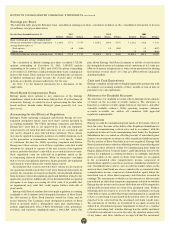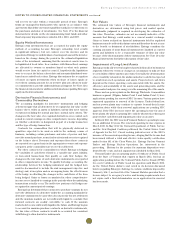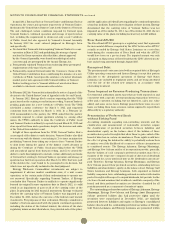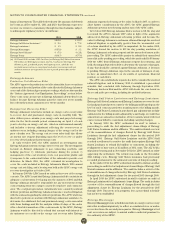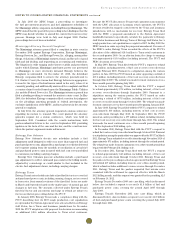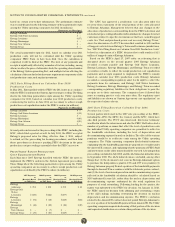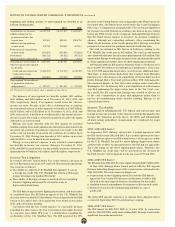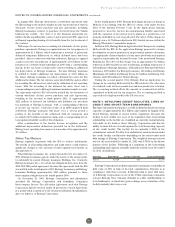Entergy 2011 Annual Report Download - page 76
Download and view the complete annual report
Please find page 76 of the 2011 Entergy annual report below. You can navigate through the pages in the report by either clicking on the pages listed below, or by using the keyword search tool below to find specific information within the annual report.
NOTES TO CONSOLIDATED FINANCIAL STATEMENTS continued
based on certain year-to-date information. The preliminary estimate
was recorded based on the following estimate of the payments/receipts
among the Utility operating companies for 2012 (in millions):
Payments or (Receipts)
Entergy Arkansas $ 37
Entergy Gulf States Louisiana $ –
Entergy Louisiana $(37)
Entergy Mississippi $ –
Entergy New Orleans $ –
Entergy Texas $ –
The actual payments/receipts for 2012, based on calendar year 2011
production costs, will not be calculated until the Utility operating
companies’ FERC Form 1s have been filed. Once the calculation is
completed, it will be filed at the FERC. The level of any payments and
receipts is significantly affected by a number of factors, including, among
others, weather, the price of alternative fuels, the operating characteristics
of the Entergy System generating fleet, and multiple factors affecting the
calculation of the non-fuel related revenue requirement components of the
total production costs, such as plant investment.
2011 Rate Filing Based on Calendar Year 2010
Production Costs
In May 2011, Entergy filed with the FERC the 2011 rates in accordance
with the FERC’s orders in the System Agreement proceeding. The filing
shows the following payments/receipts among the Utility operating
companies for 2011, based on calendar year 2010 production costs,
commencing for service in June 2011, are necessary to achieve rough
production cost equalization under the FERC’s orders (in millions):
Payments or (Receipts)
Entergy Arkansas $ 77
Entergy Gulf States Louisiana $(12)
Entergy Louisiana $ –
Entergy Mississippi $(40)
Entergy New Orleans $(25)
Entergy Texas $ –
Several parties intervened in the proceeding at the FERC, including the
LPSC, which filed a protest as well. In July 2011, the FERC accepted
Entergy’s proposed rates for filing, effective June 1, 2011, subject
to refund, set the proceeding for hearing procedures, and then held
those procedures in abeyance pending FERC decisions in the prior
production cost proceedings currently before the FERC on review.
PRIOR YEARS’ ROUGH PRODUCTION
COST EQUALIZATION RATES
Each May since 2007 Entergy has filed with the FERC the rates to
implement the FERC’s orders in the System Agreement proceeding.
These filings show the following payments/receipts among the Utility
operating companies are necessary to achieve rough production cost
equalization as defined by the FERC’s orders (in millions):
2007 Payments 2008 Payments 2009 Payments 2010 Payments
or or or or
(Receipts) Based (Receipts) Based (Receipts) Based (Receipts) Based
on 2006 Costs on 2007 Costs on 2008 Costs on 2009 Costs
Entergy
Arkansas $ 252 $ 252 $ 390 $ 41
Entergy Gulf
States
Louisiana $ (120) $(124) $(107) $ –
Entergy
Louisiana $ (91) $ (36) $(140) $(22)
Entergy
Mississippi $ (41) $ (20) $ (24) $ (19)
Entergy
New Orleans $ – $ (7) $ – $ –
Entergy Texas $ (30) $ (65) $(119) $ –
The APSC has approved a production cost allocation rider for
recovery from customers of the retail portion of the costs allocated
to Entergy Arkansas. Management believes that any changes in the
allocation of production costs resulting from the FERC’s decision and
related retail proceedings should result in similar rate changes for retail
customers, subject to specific circumstances that have caused trapped
costs. See “Fuel and purchased power cost recovery, Entergy Texas,”
above for discussion of a PUCT decision that resulted in $18.6 million
of trapped costs between Entergy’s Texas and Louisiana jurisdictions.
See “2007 Rate Filing Based on Calendar Year 2006 Production Costs”
below for a discussion of a FERC decision that could result in $14.5
million of trapped costs at Entergy Arkansas.
Based on the FERC’s April 27, 2007 order on rehearing that is
discussed above, in the second quarter 2007 Entergy Arkansas
recorded accounts payable and Entergy Gulf States Louisiana,
Entergy Louisiana, Entergy Mississippi, and Entergy Texas recorded
accounts receivable to reflect the rough production cost equalization
payments and receipts required to implement the FERC’s remedy
based on calendar year 2006 production costs. Entergy Arkansas
recorded a corresponding regulatory asset for its right to collect the
payments from its customers, and Entergy Gulf States Louisiana,
Entergy Louisiana, Entergy Mississippi, and Entergy Texas recorded
corresponding regulatory liabilities for their obligations to pass the
receipts on to their customers. The companies have followed this
same accounting practice each year since then. The regulatory asset
and liabilities are shown as “System Agreement cost equalization” on
the respective balance sheets.
2007 Rate Filing Based on Calendar Year 2006
Production Costs
Several parties intervened in the 2007 rate proceeding at the FERC,
including the APSC, the MPSC, the Council, and the LPSC, which have
also filed protests. The PUCT also intervened. Intervenor testimony
was filed in which the intervenors and also the FERC Staff advocated a
number of positions on issues that affect the level of production costs
the individual Utility operating companies are permitted to reflect in
the bandwidth calculation, including the level of depreciation and
decommissioning expense for nuclear facilities. The effect of the various
positions would be to reallocate costs among the Utility operating
companies. The Utility operating companies filed rebuttal testimony
explaining why the bandwidth payments are properly recoverable under
the AmerenUE contract, and explaining why the positions of FERC Staff
and intervenors on the other issues should be rejected. A hearing in this
proceeding concluded in July 2008, and the ALJ issued an initial decision
in September 2008. The ALJ’s initial decision concluded, among other
things, that: (1) the decisions to not exercise Entergy Arkansas’s option
to purchase the Independence plant in 1996 and 1997 were prudent; (2)
Entergy Arkansas properly flowed a portion of the bandwidth payments
through to AmerenUE in accordance with the wholesale power contract;
and (3) the level of nuclear depreciation and decommissioning expense
reflected in the bandwidth calculation should be calculated based on
NRC-authorized license life, rather than the nuclear depreciation and
decommissioning expense authorized by the retail regulators for
purposes of retail ratemaking. Following briefing by the parties, the
matter was submitted to the FERC for decision. On January 11, 2010,
the FERC issued its decision both affirming and overturning certain
of the ALJ’s rulings, including overturning the decision on nuclear
depreciation and decommissioning expense. The FERC’s conclusion
related to the AmerenUE contract does not permit Entergy Arkansas to
recover a portion of its bandwidth payment from AmerenUE. The Utility
operating companies requested rehearing of that portion of the decision
and requested clarification on certain other portions of the decision.
74


